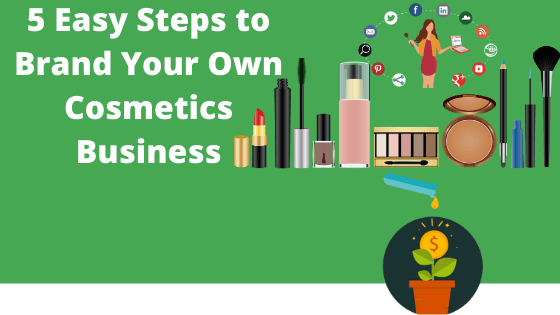Cosmetic brands make a lot of money. According to data from Allied Market Research, the cosmetic industry was worth $380.2 billion in 2019, with projections showing that it would continuously grow at a CAGR of 5.3% to stand at $463.5 billion in 2027.
That’s a lot of money, and considering that cosmetics have become a near-indispensable part of many peoples’ lives, this is a prime market for savvy business owners.
If you want to go into the cosmetic market, branding is one of the key things you must keep in mind to ensure your cosmetic brand stands out and operates profitably.
Today’s post looks at five simple steps you can take to brand your cosmetic brand effectively:
目录
Step 1: Look Into Your Competitors and Target Audience
Every successful branding campaign starts with effective market research, which revolves around understanding your competition and target audience.
1: How to conduct competitors’ research
Knowing what your competition is doing can make all the difference. It lets you see what your competition is doing right and wrong, making it easier to see what you can do differently to ensure your cosmetic brand stands out and remains competitive.
To get competitor research right, you need to do a few key things:
a: Create a list of top competitors
Even if you think you know all your top competitors, your first step should be conducting some more research, then using what you learn and find to create a list of your top competitors.
Here, Google is your friend. All you have to do is type the correct keywords. For example, you can search for “top leading cosmetic brands.”
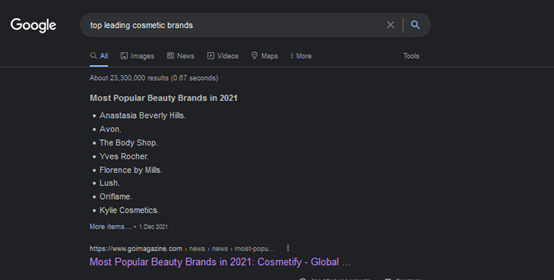
Or “top leading cosmetic brands on social media.”


Ideally, you want to focus only on the top ten competitors. You can use a web spying tool like Mozbar to narrow your list of competitors to the ten based on web analytics —traffic, DA, etc.— or social media followers and brand mentions.
b: Determine their top products
Like your competitors, you’ll be in business to offer a product/service. It is, therefore, important to analyze your top competitors to determine their product offerings, quality, and how their customers perceive these products.
As you consider the products offered by the competition, ask yourself questions such as:
- Are the cosmetic products low or high cost?
- Does the competition rely mainly on one-off purchases or volume sales?
- What share of the market does each of the competitors’ products take?
- How are the competitors’ products meeting market needs? If not, what product can you offer to fill a gap in the market?
- Which product pricing strategy does the competition use?
- What product packaging are most competitors using for specific products in their lineup? Is there logic behind this, or would a different packaging approach stand out more?
Such questions and others like them will help you determine how to package and present your cosmetic brand in a way that appeals to your target audience.
c: Research the marketing approaches
Researching your competitions’ marketing strategies —for example, social media, SEO, content marketing, campaigns, PPC—can help you discover new ways to brand and market your cosmetic brand.
For example, researching the competition’s marketing approaches may reveal that influencer marketing works better for cosmetic brands than paid ads because of privacy and data sharing policies. You can then strategize accordingly.
All in all, there’re tons of approaches to conducting competition research.
2: How to conduct target audience research
You can use different approaches to conduct target audience research for your cosmetic brand. No matter which approach you decide to use, keep the following audience research best practices in mind:
a: Conduct primary customer research
The best way to learn about your audience is to go directly to them for input—called primary customer research. You can do this through focus groups, one-on-one meetings with your existing customer base, surveys, social media interactions, etc.
You can also conduct exploratory or specific primary customer research. In the first option, your purpose is to understand your overall customer or market to create a buyer persona. In the specific primary customer research, you dig deeper to identify specific customer trends, needs, interests, etc.
b: Create a buyer persona
Creating a fleshed-out buyer persona is a great way to segment your target audience based on what drives them —why do they need your products? It lets you detail key aspects of your target audience, like demographics, interests, problems, challenges, and other metrics.
To create an effective buyer persona, use various means to get data from your current—or intended target audience. For example, you can run surveys, engage your social media community, or use your sales and customer support team to learn more about your audience.
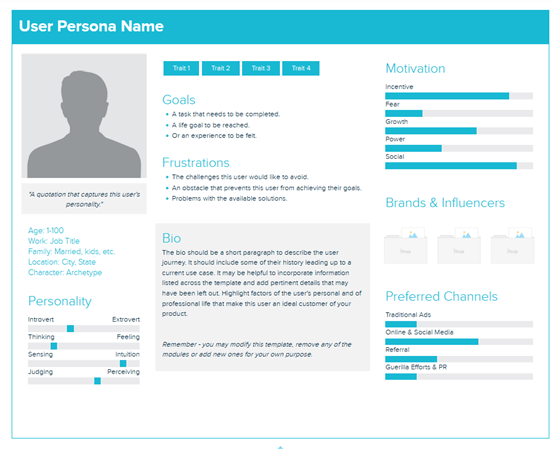
A buyer persona allows you to create a baseline target audience and can make all the difference in your branding plan for your cosmetic business.
c: Consider pain points and purchase paths
To create an effective branding strategy for your cosmetics, think about your customers’ pain points that your products solve.
Thinking about your audience’s pain points and purchase paths will allow you to create a branding and marketing plan that addresses their pain points by positioning your cosmetic products and brand as the right solution to your audiences’ problems.
For example, what considerations do your target audiences have in mind when deciding which cosmetic brand to shop from? What goals are they aiming to fulfill that your brand products would help them fulfill and achieve?
When you think about such things, it becomes relatively easier to create a spot-on audience persona that captures your audiences’ pain points and purchase paths, making it easier to create a branding and marketing story that speaks directly to them.
Step 2: Build Your Own Cosmetics Brand Voice
A well-defined brand voice is one of the easiest ways to capture customers and instill a sense of “we get you”—or brand ownership and loyalty in them.
Although there are many approaches to developing a unique brand voice that speaks directly to your customers, the rule of thumb is to ensure that your brand’s voice and tone fit the product objectives and clearly communicate the value customers will get from your cosmetic brand.
Beyond that, you can build a unique cosmetic brand voice by paying attention to the following elements:
1: Design your brand elements
Creating a unique brand identity revolves around paying attention to the following core features:
a: Typography
Typography is the creative use of typefaces to create an alluring image for your brand and bring the text to life. It involves the font used, spacing, and even the strategic use of capitalization.
There are some style guides you could have your designer follow for more appealing results. For most people, the turning point before settling on products to buy is when they can read and understand what the brand represents visually.
We could look at examples of how bigger brands in the market have taken advantage of this to get the most reaction from their target audience.


b: Color palette
These are the set of colors that represents your brand’s personality. The color you pick will appear on everything related to your brand, including the logo, website, and business cards. It’s therefore good to pay attention to your color palette choices.
In your search for the best colors for your brand, ensure that you stay away from colors picked out by brands in the same field.
Setting yourself apart ensures that clients never confuse your brand for another. Remain consistent with the color palette in all marketing drives to ensure that the image sticks with people.
Before picking your brand color, ask yourself these questions:
What feeling would you like to invoke in people?
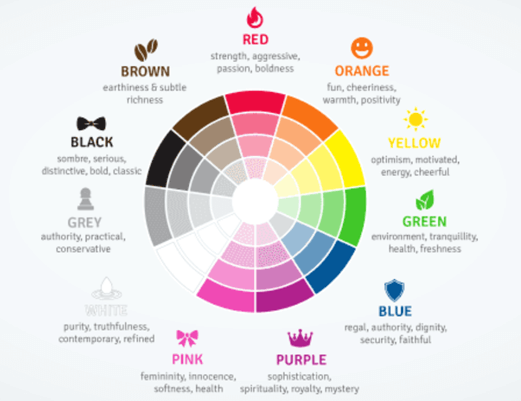
- Black: Shows edginess and sophistication.
- Yellow: Creates a feeling of happiness, youthfulness, and a sense of affordability.
- Red: Is used to show passion or excitement. Red can also create the need for urgency, which is why it works so well for product pages, promotions, and time-sensitive offers.
- Green: Represents nature and can also be used to create calmness or prosperity.
- White: White generally represents cleanliness and health, making it great for health products.
- Pink: This is a fun color and very feminine. It could work best for feminine products.
What color combination works best?
Every brand should consider having at least two colors. One should serve as the primary and the other as the secondary. Picking a combination that still portrays your brand’s primary agenda is important.
You can task each color with playing a specific role. For example, you could add bright colors like orange to draw people in, then add a neutral color to balance it out and give the eye a break to focus on the message.
c: Logo
Your logo should be simple but also very expressive and easily recognizable. It is illegal to use a logo trademarked by another brand. Therefore, before settling on a logo, do your due diligence.
Studies have shown that men are more attracted to tints-colors mixed with blacks while women are more drawn to shades-colors mixed with whites.
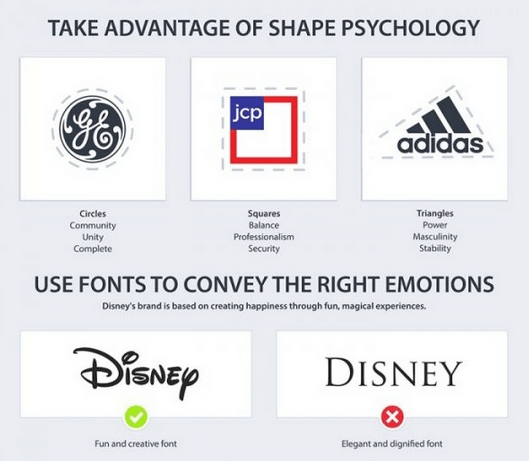
Color palette libraries available on the internet can provide a fresh eye and help you decide which logo best represents your cosmetic brand.
d: Packaging
Ultimately, your packaging choices depend on your target market —where you intend to sell your products—the nature and size of the product, and how you ship them to clients.
Branding best practice is to have a logo on your packaging to drive up exposure. Additionally, have some nice packaging options that customers can use for other things, or pass on to other people in their lives, thereby giving your cosmetic brand more exposure.
The cosmetics industry has some standard forms of product packaging that have become the norm over time; these include jars, tubes, and bottles—in glass or different types of plastics like LDPE, PET, or HDPE. It would be best to adhere to this to avoid unwarranted attention that could have unforeseen consequences.
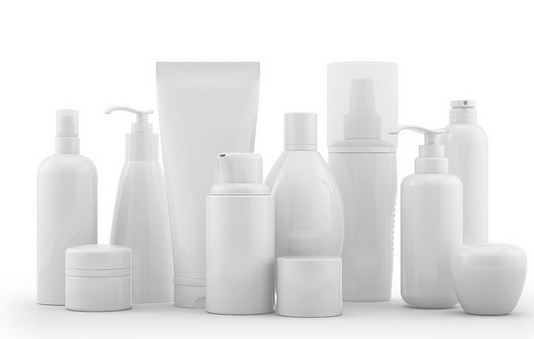
One way to remain relevant as a brand in the market is to try and cater to people’s needs, especially by meeting packaging needs they didn’t know they had. For example, you can introduce easy-to-open arthritis caps for people with arthritis.
e: Digital presence
Being present on social networks helps you stay relevant and makes it easy for customers to always be up to date with your new product launches, sales, promotions, and even giveaways.
It’s best to create a user-friendly website/sales funnel that can easily entice customers into buying products—because of the friendliness of the UI, the design elements, how well you’ve described what your products can do for customers, etc. Ensure you also optimize your website for mobile users. After all, most web visits are not mobile:

Also, have a presence on the more common social media platforms like Facebook, Twitter, LinkedIn, Instagram, Pinterest, and YouTube. Ensure you go out of your way to use these platforms effectively for branding.
For example, you can upload YouTube videos of makeup tutorials using your brand products, Facebook and Instagram to do giveaways and paid ads, and use the messaging option on most social media sites to interact with your audience base.
f: Business cards
Since business cards find their way to people who might not have heard about you before, make sure yours tells a story that inspires curiosity and make people want to know more about the brand. Ensure your business card has your logo and contact information.
Ensure that you also use a good material for your business card, adhere to basic design principles, and let your brand voice/creativity shine through in your business card elements.
2: Have consistency
The fastest way to lose clients is to keep changing your brand’s image. It confuses them and makes your brand less memorable. Additionally, keeping up with the brand changes can be very expensive for your brand and business.
Ensure that all aspects of your brand seamlessly compliment each other and that you build trust and loyalty by not changing your brand elements all too often.
Step 3: Generate Your Cosmetics Brand Style
Apart from the above points, it is in your best interest to work on other aspects of your brand to ensure it stays memorable and competitive in the market.
The key elements you need to pay attention to here include:
1: Brand story
A brand story should answer the following question:
- Who is the brain behind the brand?
- Why was the brand started?
- How do you go about doing what you do?
- Who do you do it with, and for whom (target audience) do you do it?
A brand story should be authentic and tell the impact you want to have on your target audience and society. Your business should address a problem in society and provide a solution. Your story should tell your vision, mission, and the values you hold dear. You should always end it by looking forward to a promising future.
2: Corporate mission and values
Your brand’s mission should be your driving force, and this force should be clear to your target audience. As a brand, hold yourself accountable to your core values and never compromise on them. For example, if you promise organic products, ensure all your products are exactly that, with the core ingredients sourced ethically and organically.
To easily understand your brand’s mission and core values, ask yourself:
- What do I aim to achieve with this brand in the long run?
- What motivates us to keep going?
- What does my cosmetic brand represent?
Before bringing more members on board, ensure they familiarize themselves with the brand’s mission to ensure no compromise and that they can embody this mission and core values in how they communicate with your audience.
Step 4: Market Your Own Cosmetics Business on Social Media
To survive in the present-day economy, you have to have a presence on social media. You have to tap into all the opportunities offered by social media platforms like Facebook, YouTube, and Instagram.
Here:
1: Brand yourself on social media
Ensure that your brand stands out and strive to be consistent in your branding.
Create a catchy caption so that clients stop for a double take anytime they scroll past it. Take stock on all the platforms you are active on and see which has more conversion of clicks to sales.
Ensure that key parts like the logo and color palette remain the same to make it easier for clients to identify the brand. One way to ensure this is to ensure no visual inconsistencies with your brand’s portfolio. Pick images that more or less give out the same feel in all socials.
Finally, create a persona for your brand that aligns with the social media platform used by your core audience, then tailor your brand presence to suit that group and grab more attention.
For example:
Pew Research has a very informative platform that can show you which genders are using which social media platforms the most:
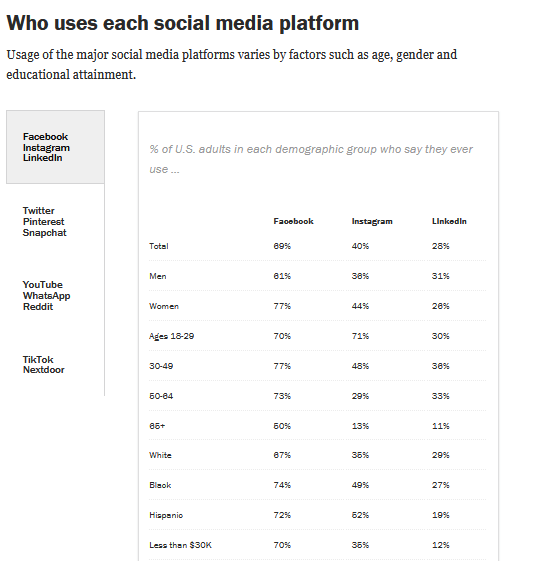
2: Market your cosmetics brand on social media
Most social media platforms offer paid ads you can use to help grow your brand exposure.

You can also choose to engage a person with a bigger following to market for you—influencer marketing—and leverage the influencer’s reach to make your cosmetic brand and products more popular.
Engaging multiple influencers can help have a viral marketing effect that makes your cosmetic brand as popular as Kylie Cosmetics or Sephora. Both brands use influencer marketing very effectively and are worth studying as you create a personalized branding plan for your cosmetic brand.
To drive more traffic to your brand:
a: Post content frequently
Ensure you are always active on your brand’s social media profiles. Content moves fast, especially now with algorithmic changes. If you fail to post consistently, your audience may easily forget your brand.
Have a consistent posting schedule and adhere to it. HootSuite dug into the data and realized that the following are the best posting frequencies for the top social media platforms:
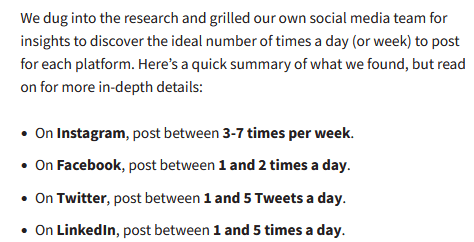
Ensure that you have catchy captions and keep your clients guessing by staying witty and jumping on developing trends like reels.
b: Respond and interact
Always be ready to answer your audiences’ questions either on your timeline or privately. Do this consistently to avoid creating a bad brand picture and reputation by getting poor “customer service” remarks from potential buyers. Avoid controversy since it could end up painting you in a bad light.
c: Work with influencers
Engaging someone with a bigger audience or presence in the cosmetic industry is always a plus because people are more likely to trust the influencer’s opinion than they are likely to trust an unknown, new brand.
You can start influencer marketing by sending PR packages to influencers in exchange for honest product reviews and brand mentions and tags in their social media posts.
NOTE: Most influencers value their audience and will give their honest opinion of the products they review. Therefore, ensure your cosmetic brand only carries high-quality products to ensure you get positive mentions.
Step 5: Find A Supplier That Can Help You Brand Your Cosmetics Business
Some cosmetic suppliers, especially those who offer drop shipping services, also have branding services and can help you create and implement a branding plan for your cosmetic line.
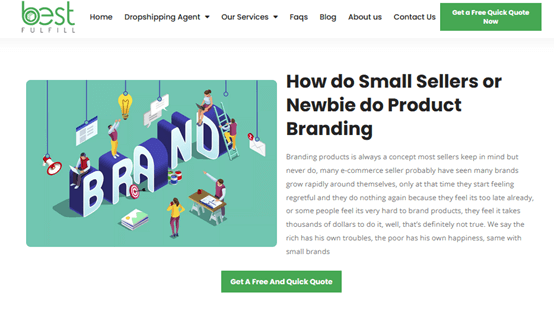
For example, here at BestFulfill, besides offering all the services you would expect from a professional drop shipping sourcing and fulfillment agency, we also offer professional branding services like:
- Logo creation
- Branding on products and packages
- Branded gift and thank you card
- Product packaging guidance
- Brand story creation
- Branded logo stickers
- And many other branding services at affordable prices
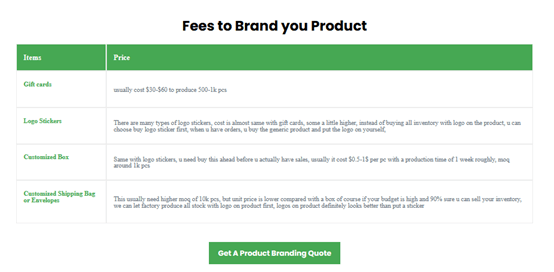
Reach out for a free quote that meets your branding need for your cosmetic brand.
Conclusion
After following these five steps, branding your cosmetic business will be easy, and your bottom line will thank you handsomely.

